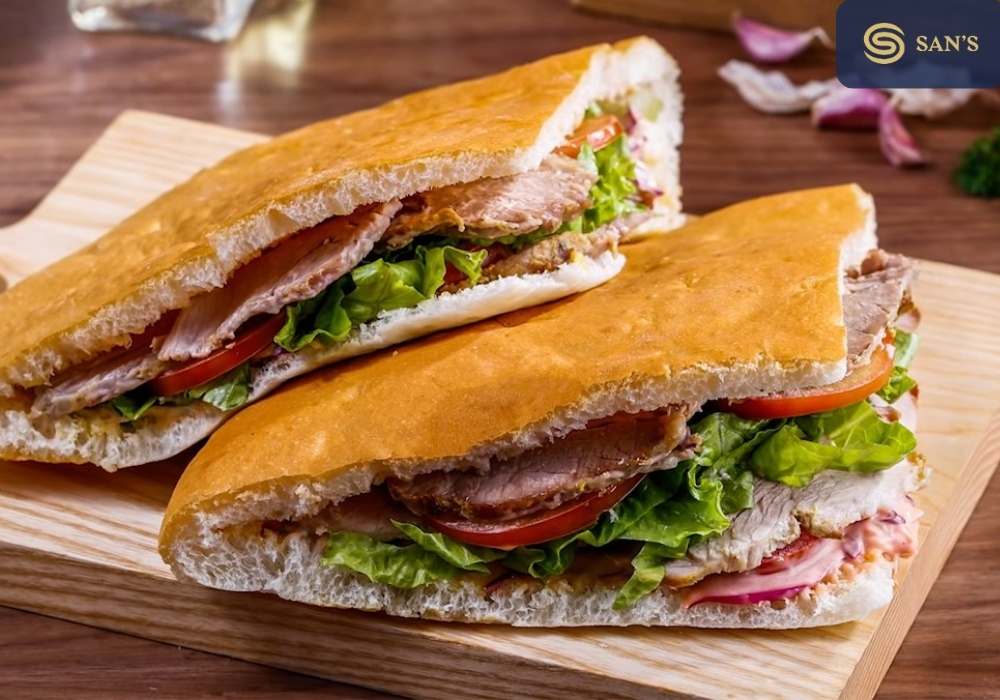In the heart of Southeast Asia lies a nation that is a culinary gem: Vietnam. A country where every bite tells a story, and where the essence of centuries-old traditions melds seamlessly with innovative flavors. This rich culinary tapestry is woven from a medley of fresh ingredients, age-old recipes, and an unyielding passion for food.
One dish, in particular, stands tall amidst this vibrant gastronomic landscape: the “banh mi“. More than just a sandwich, the “banh mi” is a testament to Vietnam’s resilience, its history of colonialism, and its ability to transform and adapt.

This humble baguette, packed with a harmony of flavors and textures, has transcended its street-food origins to become a symbol of Vietnamese pride and culinary prowess. It’s not just a favorite among locals; the “banh mi” has ventured beyond Vietnamese shores, making waves internationally and cementing its place in the pantheon of global sandwiches.
In this exploration, we’ll journey through the alleys of Vietnam to uncover the origins of the “banh mi”, delve deep into its components, and trace its meteoric rise on the world stage. Hold tight, for it promises to be a delicious ride!
The History of Banh Mi
The story of the “banh mi” is as layered and rich as the sandwich itself. To understand its origins, one must journey back to the 19th century when Vietnam was under French colonial rule. It was during this time that the French introduced Vietnam to the baguette, a staple of their own cuisine. However, the Vietnamese baguette began to evolve, becoming lighter and airier to suit local tastes and the humid climate.
But the true transformation occurred post-Vietnam War. As the country began to rebuild and find its identity, the Vietnamese people, renowned for their culinary ingenuity, started filling these baguettes with a symphony of local flavors. From the luscious pâtés and cold cuts, reminiscent of French charcuterie, to the vibrant, pickled vegetables, and fresh cilantro, a unique culinary fusion was born.

What makes the “banh mi” particularly special is its representation of two worlds. The crisp, golden baguette is undeniably French, but its soul is purely Vietnamese. The sandwich encapsulates a period of Vietnamese history where the country faced external influences but managed to make something entirely their own out of it.
Over the years, as Vietnam opened its doors wider to the world, the “banh mi” began its own journey of international conquest. From the bustling streets of Saigon to the hip eateries in New York or Sydney, its popularity soared. However, irrespective of its global footprint, the essence of the “banh mi” remains rooted in its history – a delightful amalgamation of colonial legacy and Vietnamese tradition.
Deconstructing the Banh Mi
At its core, the allure of the “banh mi” lies in the harmonious balance of its components, each playing a pivotal role in creating a flavor symphony. Let’s embark on a culinary journey, dissecting this iconic sandwich layer by layer:

- The Baguette: The backbone of the “banh mi”, the Vietnamese baguette, is a marvel in its own right. With a crust that crackles with every bite and an interior as airy as a cloud, it’s distinctly different from its denser French counterpart. This lightness ensures the bread doesn’t overpower but complements the vibrant fillings inside.
- The Proteins: The protein choices in a “banh mi” are both varied and flavorful. From the smoky nuances of grilled pork to the richness of pâté, each adds depth. Chicken offers a lighter touch, while tofu provides a delicious vegetarian alternative. The proteins, often marinated in a blend of spices and aromatics, are a nod to Vietnam’s meat-cooking traditions.
- The Fillings: Here’s where freshness takes center stage. The pickled daikon and carrot introduce a tangy crunch, cutting through the richness of the proteins. Cilantro adds an aromatic freshness, while cucumber slices bring a cooling effect. For those who like a kick, thinly sliced chili peppers introduce a fiery dimension.
- The Condiments: These are the unsung heroes, tying everything together. The umami punch of Maggi seasoning or soy sauce, combined with the creamy mayo, results in a mouthful that’s both rich and flavorful. Each condiment, though used sparingly, elevates the overall taste, ensuring every bite is a medley of savory, spicy, tangy, and umami notes.
In essence, the genius of the “banh mi” lies in its balance. No ingredient overshadows another. Instead, like a well-conducted orchestra, each plays its part to perfection, resulting in a sandwich that’s both complex in flavor yet wonderfully cohesive. It’s a testament to the Vietnamese culinary ethos: a celebration of simplicity, quality, and harmony.
Making Your Own Banh Mi
The beauty of “banh mi” is its adaptability. While it’s rooted in tradition, its versatility allows for countless variations. Ready to craft your own sandwich masterpiece at home? Let’s dive in!
Ingredients:
- Baguette: Seek out a Vietnamese bakery for the most authentic bread, or opt for a French baguette from your local bakery as a close alternative.
- Proteins: Choose between:
- Grilled pork: Marinate thinly sliced pork shoulder in garlic, honey, fish sauce, and soy sauce.
- Chicken: Thin slices marinated in lemongrass, garlic, and soy sauce.
- Tofu: Firm tofu slices marinated in a mixture of soy sauce, ginger, and garlic.
- Pâté: Available in specialty stores or upscale grocers.
- Pickled Vegetables:
- Daikon and carrot julienned. Pickle in a mixture of vinegar, sugar, and a pinch of salt for at least 1 hour.
- Fresh Fillings: Cucumber slices, cilantro sprigs, and thinly sliced chili peppers (adjust to your heat preference).
- Condiments: Maggi seasoning or soy sauce, mayonnaise (preferably with a hint of garlic), and optional hoisin sauce for added depth.

Instructions:
- If using meat, marinate for at least 2 hours or overnight for best flavor infusion.
- Grill or pan-fry your protein choice until cooked through and slightly caramelized.
- Slice the baguette lengthwise without cutting all the way through.
- If using, spread a thin layer of pâté on one side of the baguette.
- Layer your chosen protein onto the bread.
- Add the pickled daikon and carrot, followed by the cucumber slices.
- Drizzle with Maggi seasoning or soy sauce and a touch of mayonnaise.
- Finish with cilantro, chili slices, and if desired, a touch of hoisin sauce.
- Press the sandwich slightly, and enjoy!
Tips for Authentic Flavors:
- Sourcing Ingredients: Many Asian or international grocery stores will stock most, if not all, of the unique ingredients for “banh mi”.
- Freshness is Key: Use fresh herbs and vegetables for the best flavors and textures.
- Customization: “Banh mi” is all about balance. Don’t be afraid to adjust the condiments and fillings according to your taste.
Recreating this iconic sandwich at home not only brings a taste of Vietnam to your kitchen but also offers a delightful culinary adventure. Happy cooking!
Conclusion

The journey of “banh mi” from the bustling streets of Vietnam to the global culinary stage is a testament to the universality of good food. It’s a humble sandwich, yet its intricate layers of flavor mirror the rich tapestry of Vietnam’s history and cultural influences.
Every bite, from the crunchy baguette crust to the umami-packed fillings, tells a story – a story of colonial past, of East meets West, and of a nation’s ability to adapt, innovate, and create something uniquely its own.
But “banh mi” is just a fragment of Vietnam’s vast and diverse culinary landscape. Beyond this sandwich lies a plethora of dishes, each with its own tale and taste. From steaming bowls of pho to vibrant plates of spring rolls, Vietnamese cuisine beckons with a promise of flavor adventures.
As we wrap up our deep dive into the world of “banh mi”, we urge you, dear reader, to not just stop at this sandwich. Venture forth, explore, and allow your palate to dance to the myriad flavors of Vietnamese food. Whether you’re sampling dishes in a Vietnamese heartland or trying your hand at creating them in your kitchen, remember that every dish has a story, and every story is worth savoring.





